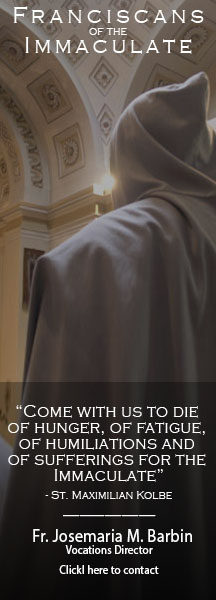In the now-famous vision of his youth, St. Maximilian was offered two crowns by Our Lady: the white crown of a life of heroic virtue, and the red crown of martyrdom. He was rewarded with these two crowns for a life totally spent for the Immaculate. By divine Providence, the Church has seen fit to confirm this gift given to a Saint whose love knew no bounds.
St. Maximilian Kolbe is an ideal model for the contemporary age. Friar, priest, missionary and martyr, he was proclaimed the “patron saint of our difficult [20th] century” by Bl. John Paul II. At a time when vocations to the religious life and the missionary drive seemed to be beating a retreat, Fr. Kolbe proposed to “march forward” by means of total consecration to the Immaculate. This was, for him, the solution to the evils of our day. As such, he anticipated the realization of the promise made by Our Lady of Fatima: My Immaculate Heart will triumph.
Preparation
Raymond Kolbe grew up in a humble and devout family in which prayer and a steady work ethic defined the daily rhythm of their life. His character solidly rooted in the formation received in this “domestic church,” the future Saint then distinguished himself in his seminary studies with the Conventual Franciscans, first at Lwow and then at Rome. He was admired for his uncommon intelligence and piety. Fr. Stefano Ignudi, rector at the College of San Teodoro in Rome, where St. Maximilian pursued his studies in philosophy and theology, had this to say about him:
He was an angel, a saint; full of fervor and zeal, one of the most observant [religious] and one of the brightest students this college has had… a holy young man.
St. Maximilian recorded the following during the spiritual retreat he made in preparation for priestly ordination: “Maximilian, be a saint. If others have done so, why can’t you?”
After returning to Poland in 1920, he wrote: “I must be a saint, the greatest saint possible. Remember that you are the absolute, unconditional, unlimited, irrevocable property of the Immaculate… All the fruit of your activities depends on union with her… My life (at every moment), my death (where, when and how) and my eternity are yours, O Immaculate. Do with me whatever you wish.”
In 1923, St. Maximilian prepared a detailed program for the reform of the Conventual Franciscans, in cooperation with Fr. Cornelius Czupryk, his Provincial Superior. The program was organized around two foci: 1) ardent devotion to the Immaculate; 2) zeal for religious observance, distinguished by the following characteristics:
- perfect observance of the common life and strict observance of poverty;
- blind obedience to the superiors concerning legitimate matters;
- avoidance of speech even remotely contrary to chastity;
- meditation each morning and evening (in common, if possible);
- particular and general examination of conscience each day.
Beatification: The “White Crown”
Even in this life, St. Maximilian’s personal commitment and good example earned for him a reputation for holiness. This aura of sanctity gleamed ever more brightly after his death in the concentration camp of Auschwitz. The Polish, Italian, German, Japanese and American press all testified to his heroism.
Cardinals and bishops, religious families and pontifical universities directed their supplications to Rome to begin the canonical process required for recognition of his heroic virtue. And so the cause for his beatification opened in 1948. On July 29, 1961, the Sacred Congregation of Rites gave Remissorial letters to the Potulator for the cause, Fr. Antonio Maria Ricciardi, for the canonical processes to be carried out in the episcopal sees of Padua (Italy), Trenton (New Jersey), Nagasaki (Japan), Warsaw and Krakow (Poland).
On January 30, 1969, Pope Paul VI approved his heroic virtues “without further delay.” Numerous cures attributed to the intercession of Fr. Kolbe were submitted for verification. The Postulation presented two of these: the instantaneous and complete healing of Angelina Testoni (Sassardi, Italy) from intestinal disorders and tuberculosis on July 24, 1949, and of Francesco Luciani Ranier (Montegranaro, Italy), who, on the night of August 5, 1950, was healed of an acute infectious cough and a grangrenous limb.
On October 17, 1971, in the Basilica of the Holy Apostles in Rome, in an event officiated by the Conventual Franciscans, Fr. Kolbe was inscribed into the register of the Blessed as Confessor of the Faith. Paul VI thus conferred upon the Polish Franciscan the “white crown” that Our Lady had promised him in the famous vision of his childhood. There remained the “red crown” to confer, also promised in the same vision.
The “Red Crown” and Canonization
Only a month after his beatification, the Postulator for his cause, Fr. Antonio Maria Ricciardi, expressed his conviction that Fr. Kolbe had died a martyr. In conducting the process of his beatification, the Congregation for the Causes of the Saints had followed wise and prudent counsel in adhering to the procedures established for confirming Confessors of the Faith. Providentially, this approach gave greater relief to the heroic virtues Fr. Kolbe practiced, independent of his final offering in place of a condemned father of a family at the concentration camp of Auschwitz.
The recognition of a martyr requires the verification of two criteria: 1) on the part of the persecutor, hatred of the Faith or of works connected with the Faith; 2) on the part of the martyr, the licit performance of a work directly or indirectly obligatory by reason of the virtue of faith, forbidden by an iniquitous law of a tyrant.
How could one not recognize a tyrannical attitude on the part of the German S.S. who oppressed St. Maximilian? They knew well that Fr. Kolbe performed activities of a strictly religious nature. While incarcerated at Pawiak, he was mistreated precisely because he was a religious. Religious books, images and objects were strictly prohibited there. On one occasion, Fr. Kolbe was subjected to physical violence because he affirmed his belief regarding the crucifix attached to the rosary that formed part of his Franciscan habit. The behavior of the concentration camp guards was so brutal that many of the inmates preferred death by firing squad or by electrocution through contact with the electric fences.
In these circumstances, St. Maximilian maintained his composure and made human the horrors of Auschwitz, offering his pieces of bread and his soup to the younger prisoners. The prisoners thought only of their personal survival, pinning their slim hopes on escape from the prison. By his knowledge of the German language, his affability even with the guards and his stay in the infirmary, St. Maximilian had the greatest chance as anyone else of surviving. But he preferred to imitate Christ by demonstrating the “greatest love” in laying down his life for the brethren. He accompanied others condemned to death into the hunger bunker, arousing confusion and admiration in the guards and other prisoners: he loved to the end.
Thanks above all to studies conducted by Fr. Adam Kubis, Fr. Joachim Bar and Fr. George Domanski, and to a group of bishops from Germany and Poland who petitioned the Apostolic See, Fr. Maximilian Kolbe received the “red crown” at last on October 10, 1982, when he was canonized by Pope John Paul II. The Holy Father enrolled him among the martyrs—a wonderful surprise for those who knew the Saint who had lain down his life as a “Catholic priest,” an alter Christus.

